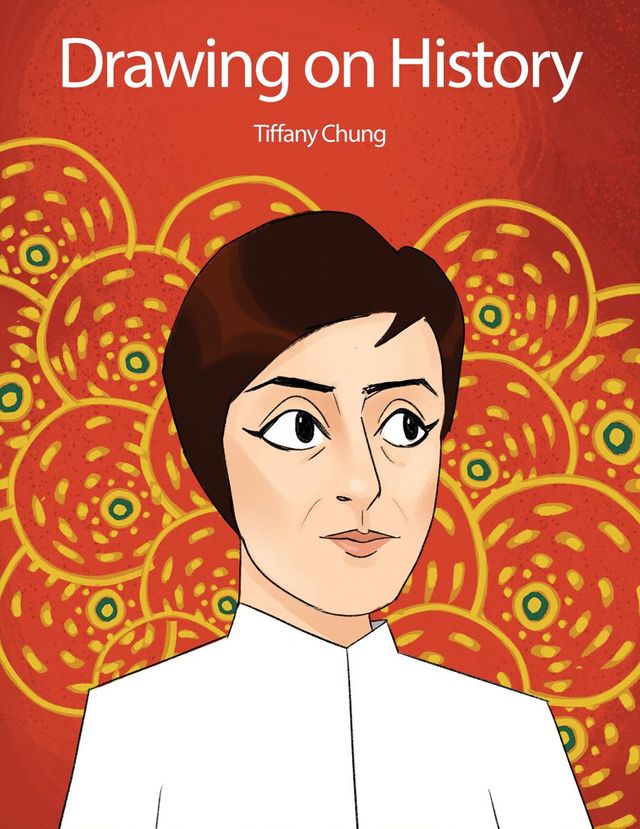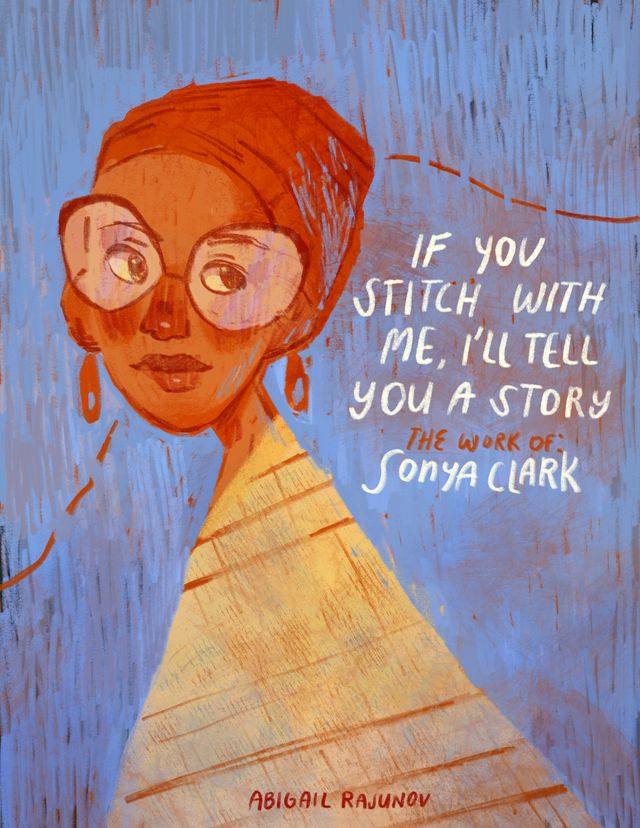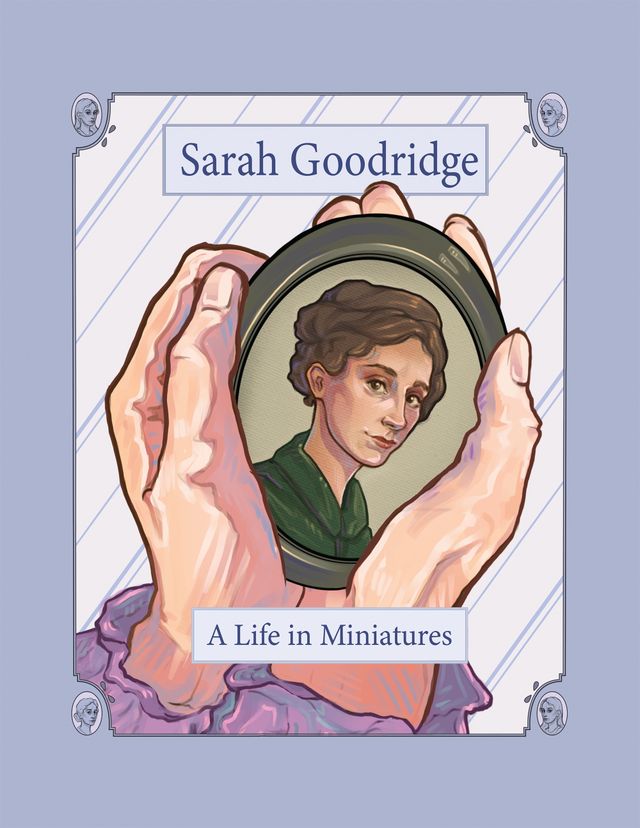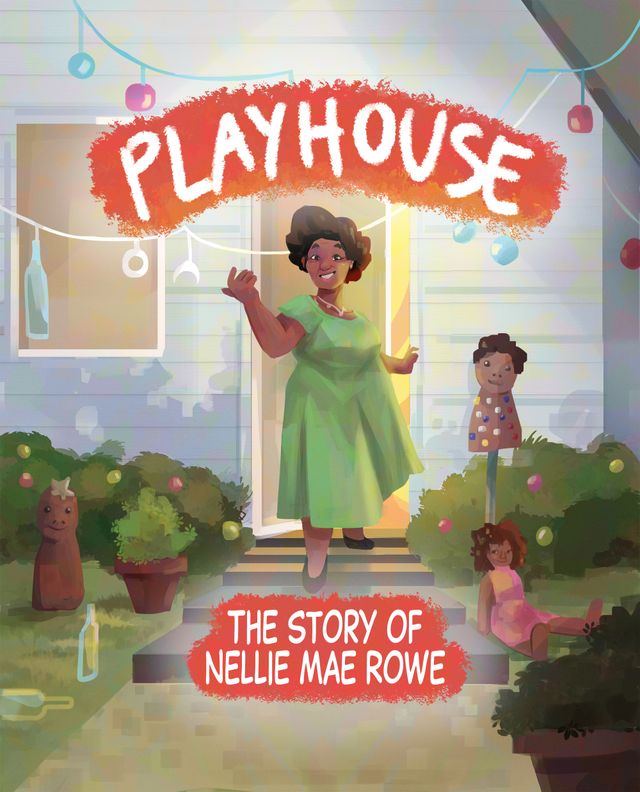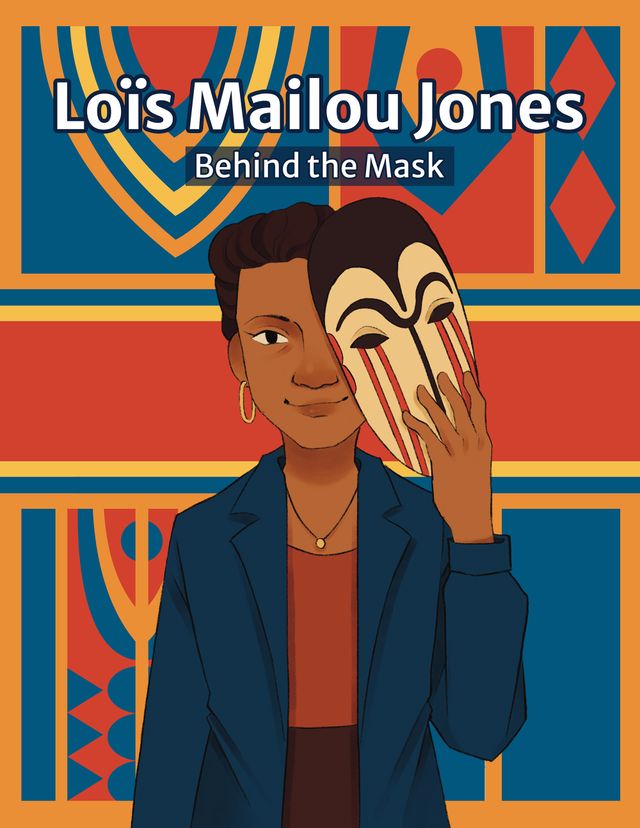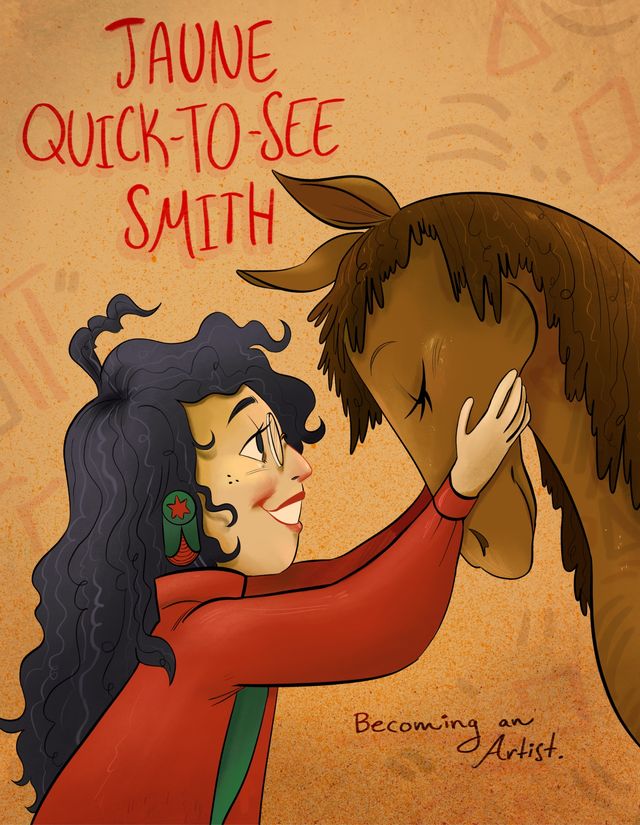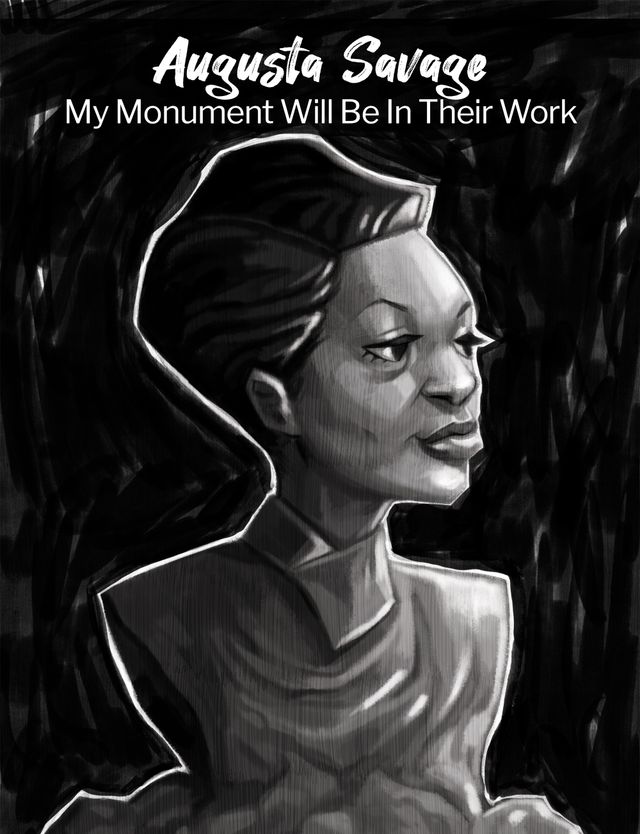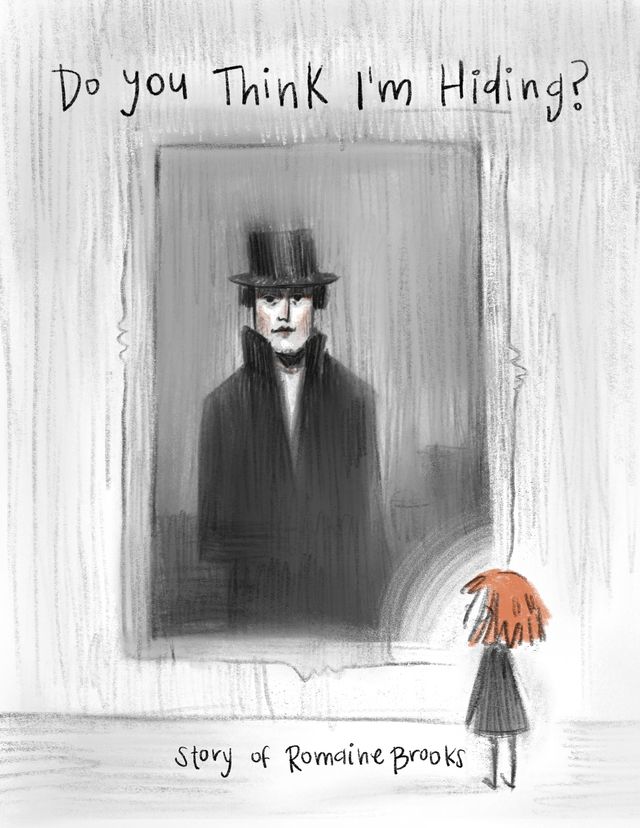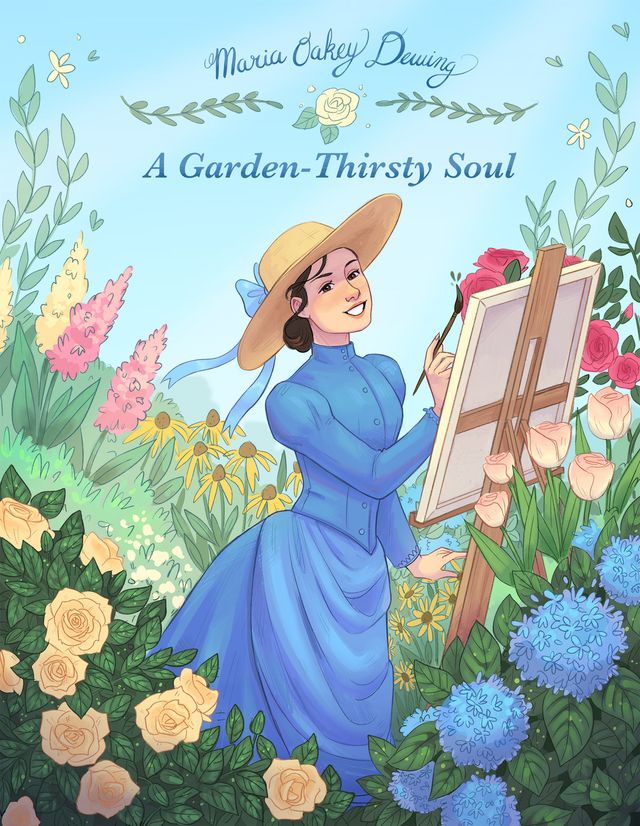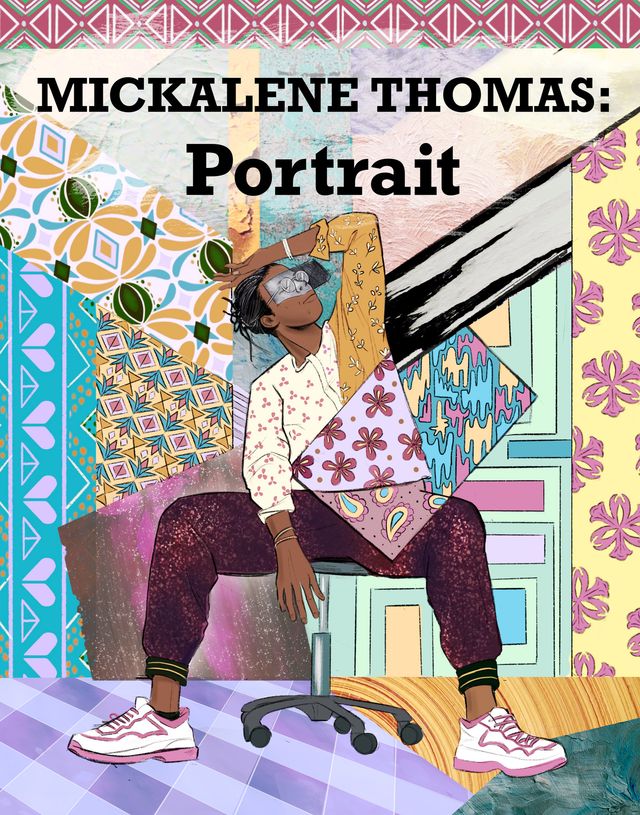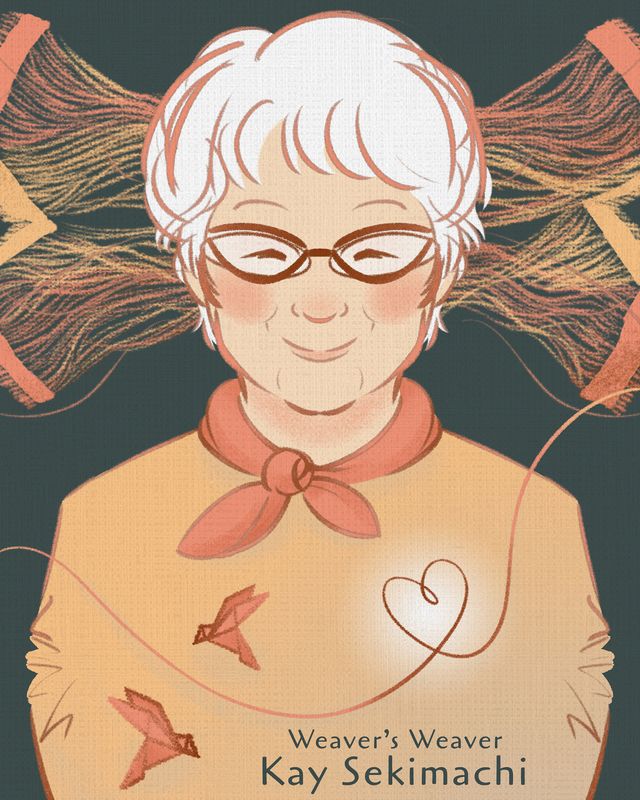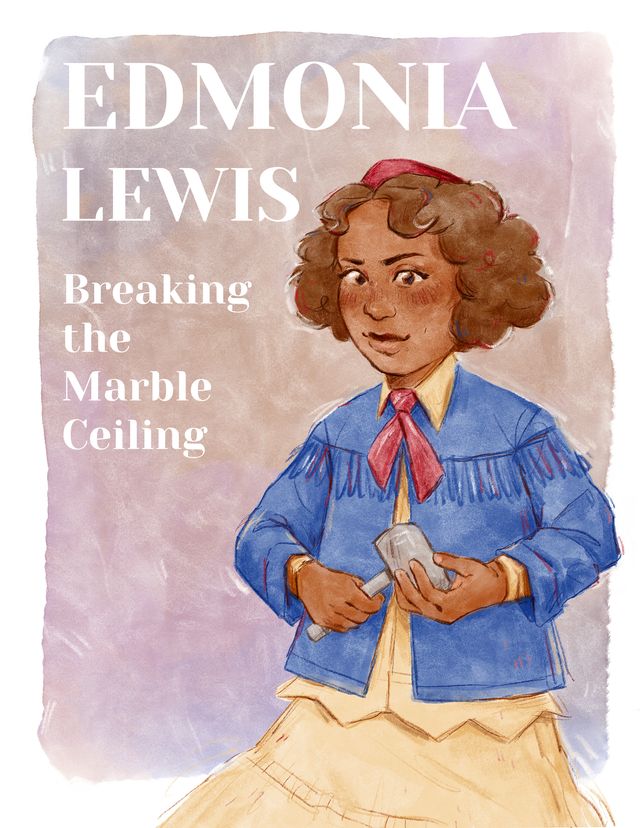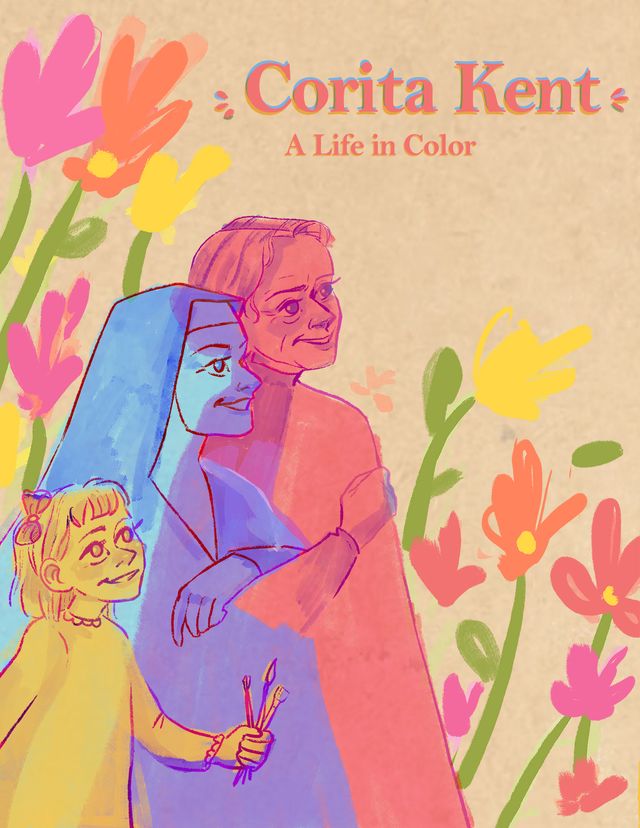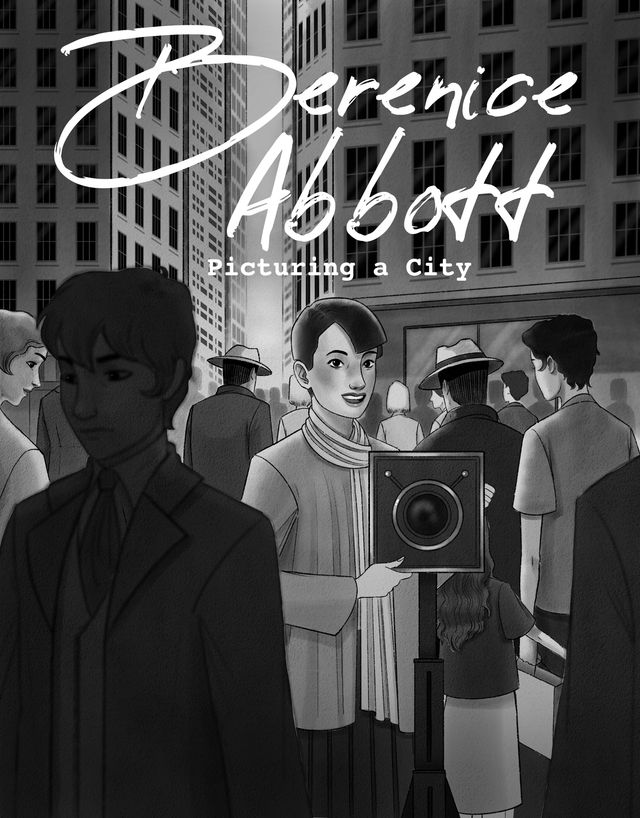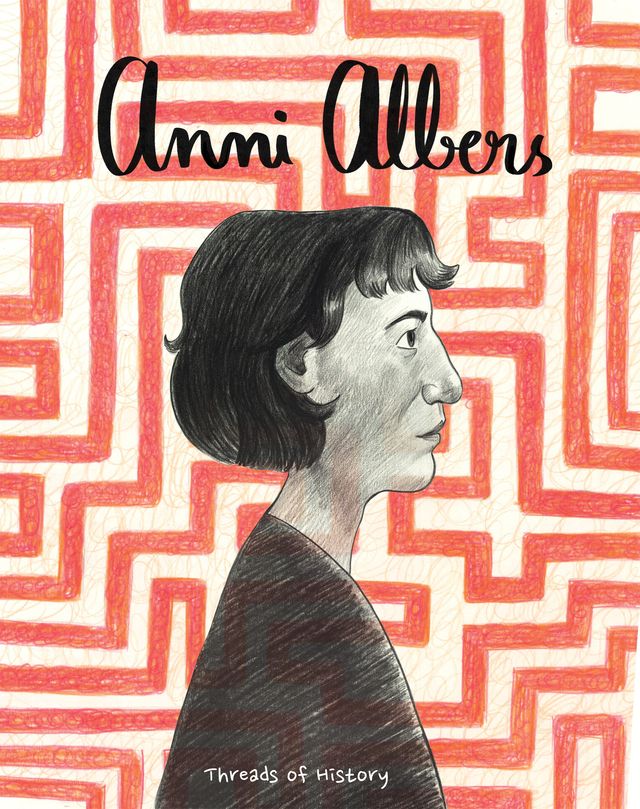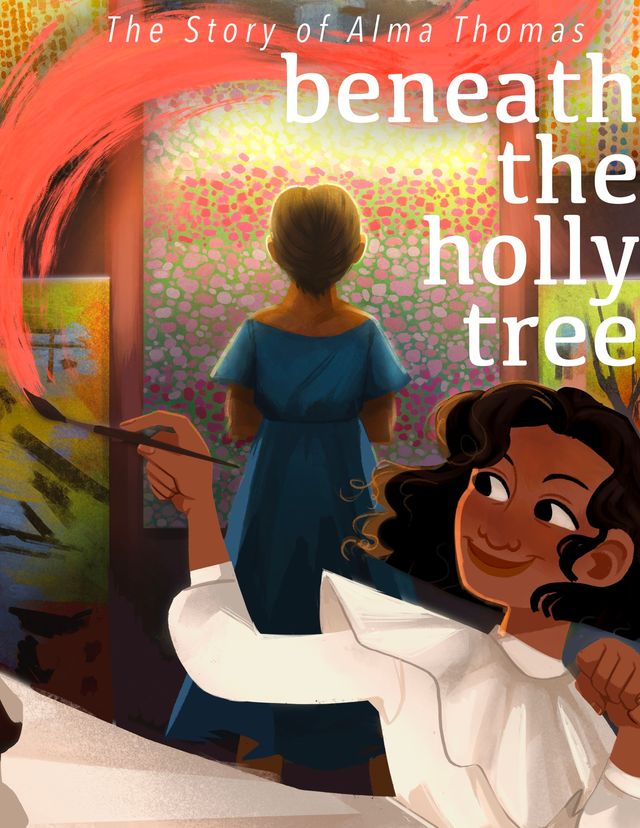An Overview
Born in a farmworker family, Ester Hernandez saw her family and community as the main inspirations for her art. She became one of the leading female artists of El Movimiento, telling stories of women and empowering Chicana feminists through her transformative work.
This comic is part of a series Drawn to Art: Tales of Inspiring Women Artists that illuminates the stories of women artists in the collection of the Smithsonian American Art Museum. Inspired by graphic novels, these short takes on artists’ lives were each drawn by a student-illustrator from the Ringling College of Art and Design.
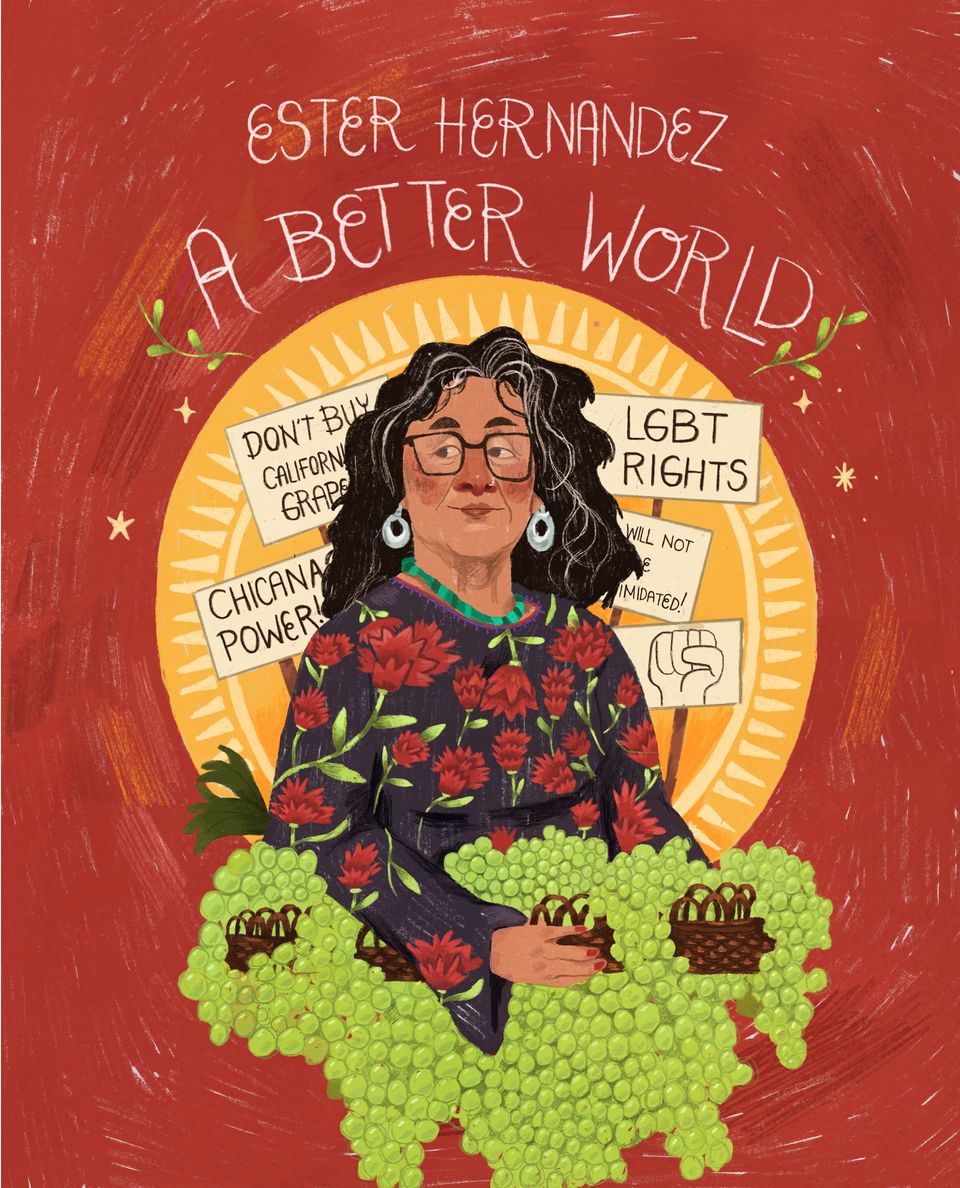
Ester Hernandez stands proudly in the center, holding a large basket of green grapes that spill to the bottom of the page. Ester has light brown skin and is wearing a black shirt with a red floral print, shiny silver earrings, and a turquoise necklace. She smiles slightly and seems content, with her eyes looking sideways under her black square glasses. Her hair is a stark black color with a few strands of gray that frame her forehead. The background is a parody of the Sun-Maid raisin box, a reference to her screen prints Sun Raid and Sun Mad. Behind Ester are protest signs, which read: Chicana Power, Don’t Buy California Grapes, LGBT Rights, We Will Not Be Intimidated, and a symbol of a fist.
Text at the top of the page reads: “Ester Hernandez A Better World.”
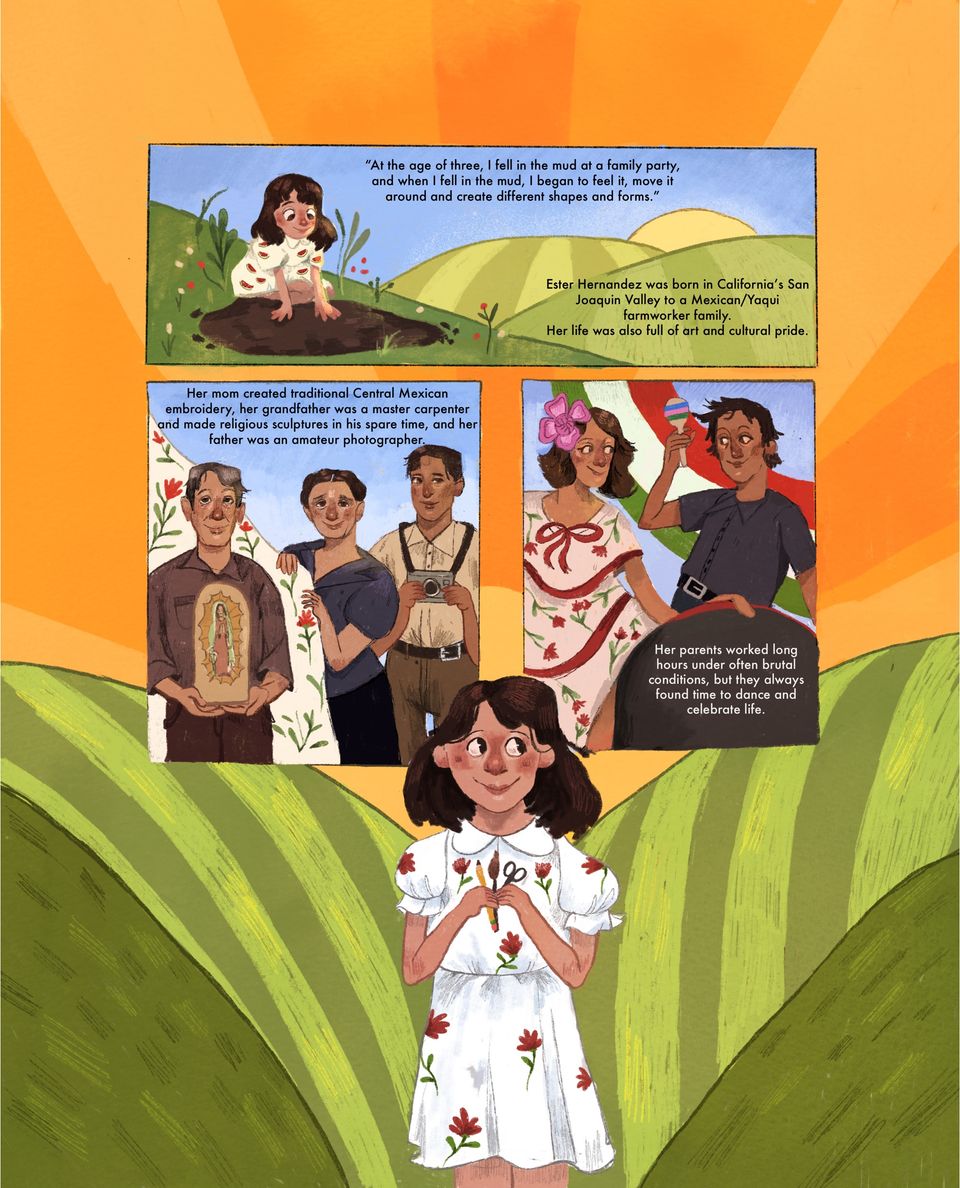
Panel 1:
The first panel is Ester Hernandez as a child, playing on the sunny hills of the San Joaquin Valley where she grew up. Her hair is brown and shoulder length. She is wearing a white dress in a red and green watermelon slice print. She sits on her knees with her hands in the mud, smiling sweetly. Small delicate flowers surround her, and the sun rises over the bright green hills behind her. The sky above her has a quote from Ester that reads: “At the age of three, I fell in the mud at a family party, and when I fell in the mud, I began to feel it, move it around and create different shapes and forms.” To the right, a bright green hill contains the text: “Ester Hernandez was born in California’s San Joaquin Valley to a Mexican/Yaqui farmworker family. Her life was also full of art and cultural pride.”
Panel 2:
Just below the first panel is a lineup of Ester’s family standing proudly, each holding objects they use to create artwork. Ester’s grandfather is on the left. He has greying, short hair, brown skin, and brown eyes, and is wearing a light brown button-down shirt rolled up to his elbows, and dark brown pants. He is holding a small, wooden religious sculpture of the Virgin of Guadalupe. Next to him is Ester’s mother. She has dark brown hair parted down the middle and pulled away from her face, brown skin and brown eyes. She is wearing a puffed sleeve blue blouse and a black skirt. She is proudly showing her central Mexican embroidery; it’s a long white cloth embroidered with red flowers and green leaves. Lastly is Ester’s father, the tallest of the group; he has short brown hair, brown eyes, and brown skin and is wearing a tan button-down short sleeve shirt and brown pants held up with a brown belt and a silver buckle. He holds up a silver camera on a brown strap that goes around his neck. Their expressions are soft as if they’re taking a group picture. Above them, the text explains, “Her mom created traditional Central Mexican embroidery, her grandfather was a master carpenter and made religious sculptures in his spare time, and her father was an amateur photographer.”
Panel 3:
The third panel is adjacent to the second. Ester’s mother and father are happily dancing together. Behind them is a banner with Mexican flag colors: green, white, and red. Her mother is wearing a traditional white Mexican dress adorned with red flowers and a red ribbon. Clipped onto her hair is a bright pink flower with open petals. She’s swinging her skirt while looking at her husband, who is dancing and shaking maracas on the right. He wears a grey short sleeve buttoned shirt, grey pants, and black belt with a sliver buckle. Text reads: “Her parents worked long hours under the often brutal conditions, but they always found time to dance and celebrate life.”
Panel 4:
At the bottom of the page, Ester is slightly older than she was in the first panel. She stands in front of panels 2 and 3. She is looking off to the right and holding a pencil, a paintbrush, and scissors. Her white dress has small red flowers with green leaves, a peter-pan collar, puffy short sleeves, and flouncy skirt that ends just at her knees. The bright green hills of the San Joaquin valley roll towards her. The sun is a bright orange, with rays shining outwards and off the page.

The illustration takes up the entire page. Ester stands with a playful smile in the center of the page with her hands on her hips. Family pride runs deep within her. Her hair is flowing and goes slightly past her shoulders; a few gray hairs that frame her forehead. Ester is dressed in a white flowy peasant-style shirt with wide sleeves and dark blue jeans. She wears a bright blue necklace and silver earrings. She is still in the San Joaquin Valley, and expansive vineyards and bright purple grapes fill the background behind her. The bright orange sky above her contains text that reads “From an early age Ester and her siblings were encouraged to be proud of who they were, to be proud of their culture, and stand up for the rights of not only themselves but their family and community. The Chicano Movement, known as El Movimiento, focused on creating a new identity for Mexican Americans.” The sun sets just below the sky, inside it text reads, “They fought for social justice and farmworker’s rights.” Behind Ester are four large picket signs; from left to right, they read: “Yo Soy Chicana, NOT Hispanic, Get it right; Brown & Proud; I will not sell my family to the grower!; and Don’t buy California grapes! Ester’s shirt contains text that reads: “The movement allied themselves with people around the world who were facing injustice.” Just below her hips is a panel with text that reads: “In a predominantly men’s movement, Ester became a leading artist to capture the voice of the mujeres. ‘I was born into the Movimiento.’ In her women-centered farm family, it was the women who along with their families were involved in labor strikes.”
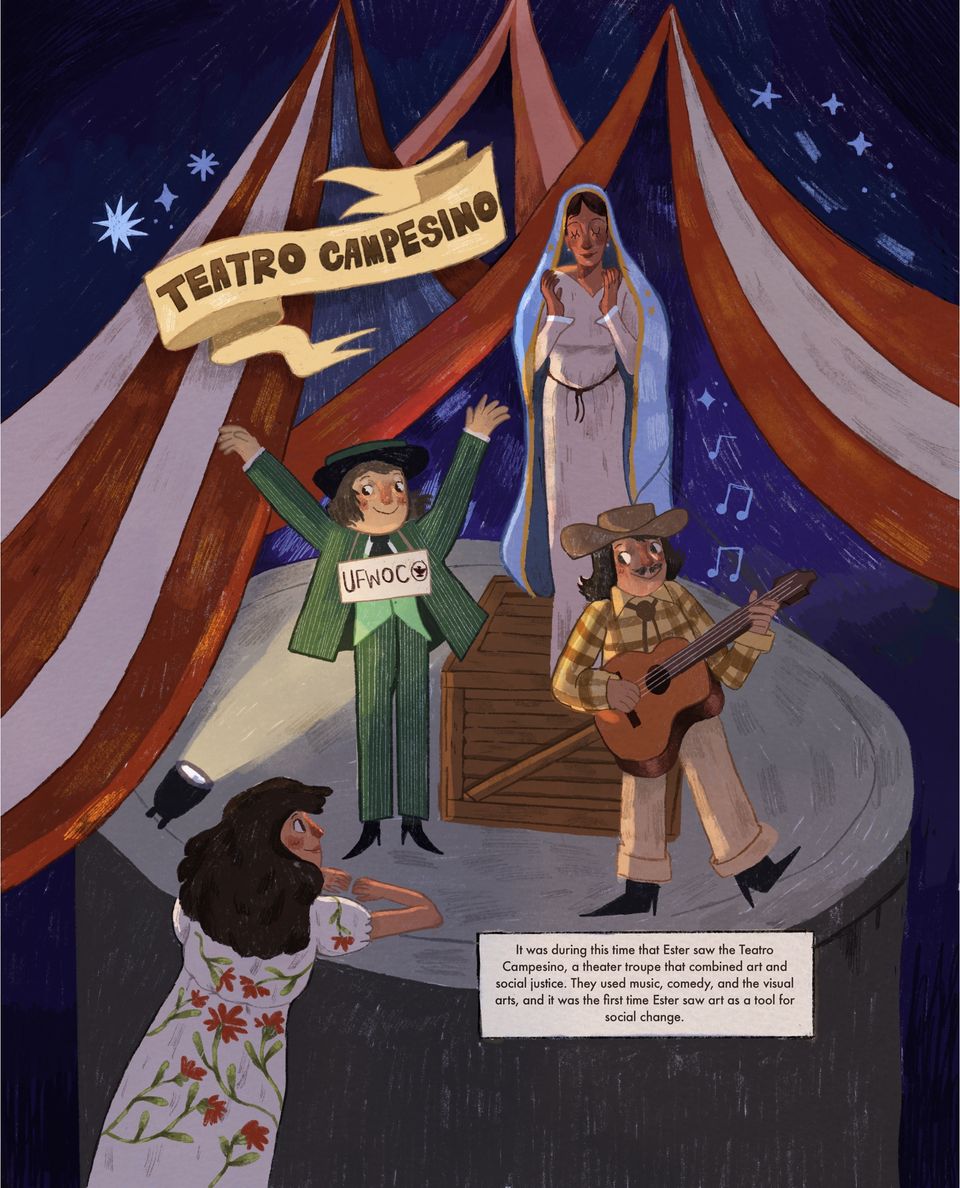
The illustration takes up the entire page. Ester, now a young woman, is visiting the famous El Teatro Campesino, a Mexican theater troupe that combined performance with social justice. She stands at the bottom of the page with her hands resting on the stage. She wears a white dress with a red floral pattern and puffy sleeves. Her dark brown wavy hair falls below her shoulders. Despite the dark lighting, the mood is bouncy and inspiring as Ester admires the three performers. On the left, a man with short brown hair and medium brown skin gestures with his arms out. He is wearing a green hat and coordinating a green pin-striped suit and vest. Around his neck is a sign that says OFWOC, which stands for United Farm Workers Organizing Committee. In the center of the stage is an actress wearing a costume of the Virgin of Guadalupe. She is wearing a long flowing white robe and is posed just like the religious figure, her hands raised and a cloth with a gold border draping over her head and shoulders. The final person on stage is a guitar player. He has dark brown hair that falls to his shoulders, medium brown skin, brown eyes, and wears a cowboy hat and a thick mustache, a brown and yellow plaid shirt and beige pants. His black shoes are well-polished and pointy. He’s smiling at Ester while strumming the guitar; Ester smiles back at him. Over the stage are tent-like decorations with red and white stripes. A banner reads Teatro Campesino. Surrounding the actors are little blue sparkles, stars, and musical notes. A panel at the bottom right contains text which reads, “It was during this time that Ester saw the Teatro Campesino, a theater troupe that combines art and social justice. They used music, comedy, and the visual arts and it was the first time Ester saw art as a tool for social change.”
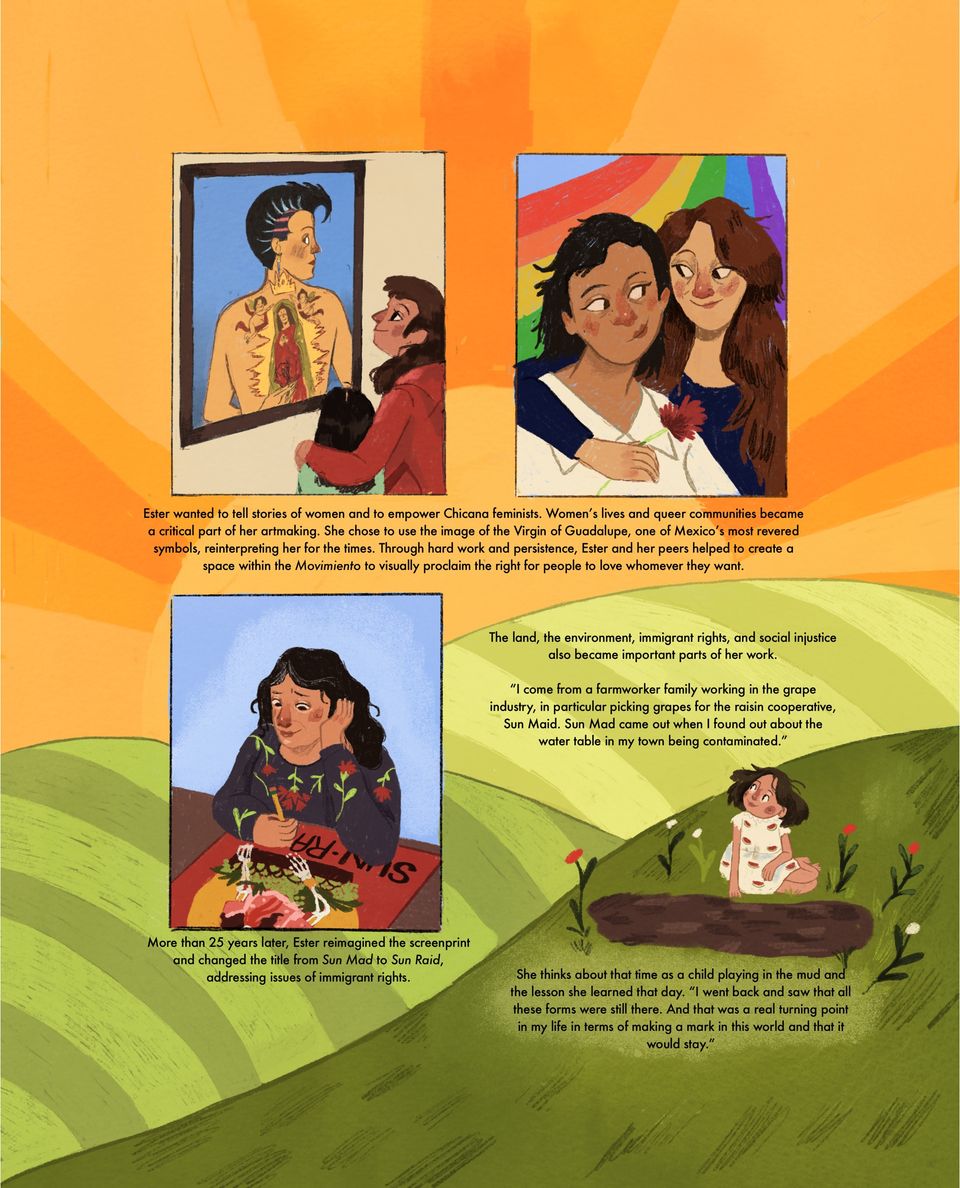
Panel 1:
A mother and her child stand together in a museum gallery. The mother viewing the art is at a profile view with a serene smile. She has long brown wavy hair, medium brown skin, brown eyes, and she is wearing a red blouse. The mother’s arm is wrapped around her child’s shoulders. The child is wearing a pale green shirt, has shoulder-length brown hair and faces away from us. They are both looking up at Ester’s artwork, La Ofrenda II, a screen print of Ester’s partner’s bare back. Their partner’s dark hair is worn in a pompadour style. Their head is head turned to the left, as they look over their shoulder. A large, colorful tattoo of the Virgin of Guadalupe takes up most of their back. The religious figure is surrounded by heavenly rays and two baby angels holding a large crown.
Panel 2:
An LGBTQIA+ couple looks at each other lovingly. The woman on the left has brown skin, short black hair, and wears a cream-colored collared shirt. She smirks playfully as her partner puts an arm around her shoulders, holding a rose in front of her. Her partner has light skin and very long, layered brown hair. A rainbow Pride flag swings behind them. Just below panels one and two text reads: “Ester wanted to tell stories of women and to empower Chicana feminists. Women’s lives and queer communities became a critical part of her artmaking. She chose to use the image of the Virgin of Guadalupe, one of Mexico’s most revered symbols, reinterpreting her for the times. Through hard work and persistence, she and her peers helped to create a space within the Movimiento to visually proclaim the right for people to love whomever they want.” Just below, and to the right of these panels, are the green hills of the San Joaquin Valley and orange and yellow rays of a sunset stretch across the page behind the upper panels. Text in the hills below reads, “The land, the environment, immigrant rights, and social injustice also became important parts of her work.” A direct quote from Ester reads, “I come from a farmworker family working in the grape industry, in particular picking grapes from the raisin cooperative, Sun Maid. Sun Mad came out when I found out about the water table in my town being contaminated.”
Panel 3:
Ester sits at a brown table, wearing a black long sleeve top patterned with red flowers. Her dark brown hair falls in long waves around her shoulders, silver strands frame her face. She’s sketching a redesign of her print Sun Mad and re-envisions it to Sun Raid, a commentary on immigrant rights. On the page a drawing of a skeleton figure looms over a large pile of grapes. As Ester sketches with her right hand, her left hand rests on her face. She seems relaxed and proud of her work. Just below this panel text reads: “More than 25 years later, Ester reimagined the screen-print and changed the message from Sun Mad to Sun Raid, addressing issues of immigrant rights.”
Panel 4 :
The final illustration is of Ester as a child playing in the mud again; it’s a reference to the first panel of the comic. She's still surrounded by flowers and wears her white dress with a red and green watermelon slice pattern. She leans to one side with one arm supporting her while the other arm rests on her lap. Young Ester is looking up at the panels on the page above, like she’s looking forward to all the accomplishments she has coming her way. Just below the patch of mud is text that reads, “She thinks about that time as a child playing in the mud and the lesson she learned that day.” It’s followed by a quote by Ester that says, “I went back and saw that all these forms were still there. And that was a real turning point in my life in terms of making a mark in this world and that it would stay.”

The final page is a symbol that represents Ester’s life, a bunch of green grapes against a pale blue background. Text reads: “Illustrated by Stephanie Bravo”.














